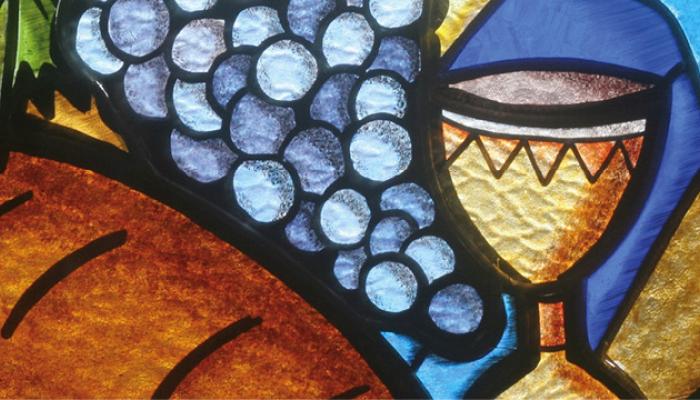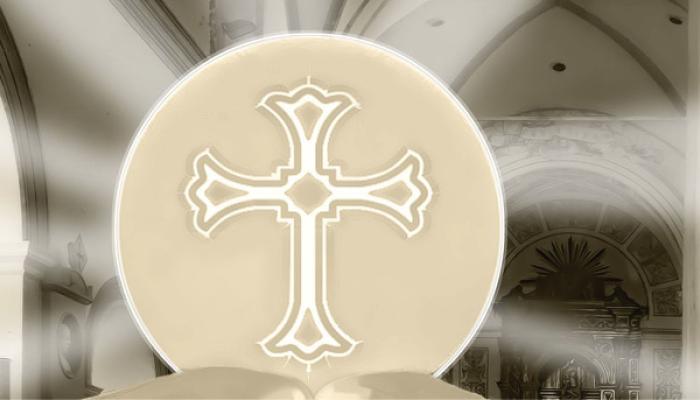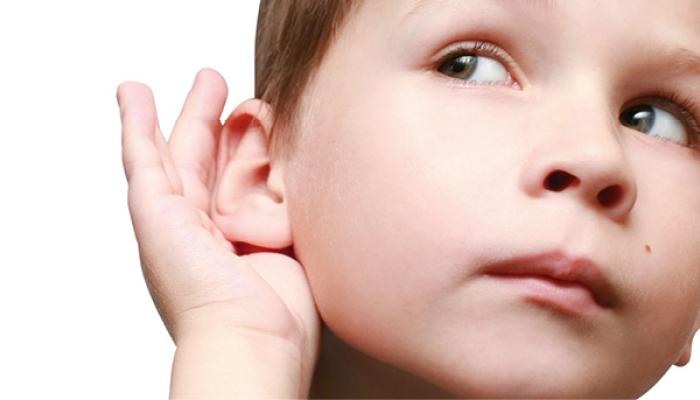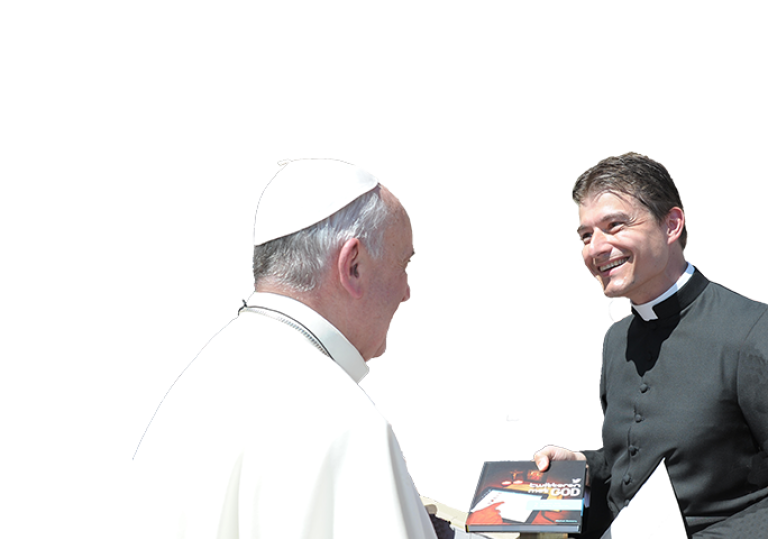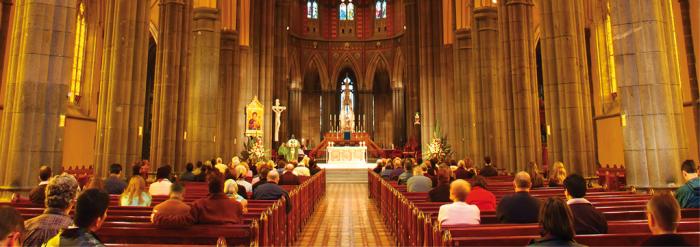
3.45 Як відбувається Свята Меса в Римському обряді?
Кожної неділі або, якщо можливо, кожного дня ми збираємося разом як християни, щоб зустрітися з Ісусом в Євхаристії. У застосунку #TwGOD ви можете знайти стандартні тексти Меси багатьма різними мовами.
Літургія Євхаристії складається з чотирьох великих частин:
1) Обряд відкриття
2) Літургія Слова, в якій Бог промовляє до нас через Біблію
3) Літургія Євхаристії, в якій Ісус жертвує Себе повністю, через Своє тіло та кров
4) Заключні обряди
What elements are essential to a Holy Mass?
Every Holy Mass (celebration of the Eucharist) unfolds in two main parts, the Liturgy of the Word and the Liturgy of the Eucharist.
In the Liturgy of the Word, we hear readings from the Old and New Testament and also the Gospel. Besides that there is an opportunity for preaching and general intercessory prayers. In the subsequent Liturgy of the Eucharist, bread and wine are offered, consecrated, and distributed to the faithful at Communion. [Youcat 213]
How is the Mass structured?
Holy Mass begins with the gathering of the faithful and the entrance of the priest and the others who serve in the sanctuary (altar servers, lectors, cantors, and so on). After the greeting comes the Penitential Rite, which concludes with the Kyrie. On Sundays (outside of Advent and Lent) and feast days, the Gloria is then sung or recited. The prayer of the day introduces one or two readings from the Old and New Testament, followed by the responsorial psalm. Before the Gospel is read, there is an Alleluia, or acclamation. After the proclamation of the Gospel on Sundays and feast days, the priest or deacon gives a homily at least on Sundays and feast days. Then, again only on Sundays and feast days, the congregation professes its common faith in the Creed, followed by the intercessions. The second part of Holy Mass begins with the preparation of the gifts, which concludes with the Offertory prayer. The high point of the Eucharistic celebration is the Eucharistic Prayer, which is introduced by the Preface and the Sanctus. Now the gifts of bread and wine are transformed into the Body and Blood of Christ. The Eucharistic Prayer concludes, finally, in the doxology, which makes the transition to the Lord’s Prayer. Then comes the prayer for peace, the Agnus Dei, the breaking of the bread, and the distribution of the holy Gifts to the faithful, which often is done only under the form of the Body of Christ. Holy Mass ends with meditation, thanksgiving, a concluding prayer, and a blessing by the priest.
The Kyrie
Celebrant. Lord, have mercy!
Response. Lord, have mercy!
C. Christ, have mercy!
R. Christ, have mercy!
C. Lord, have mercy!
R. Lord, have mercy!
C. Kyrie eleison! R. Kyrie eleison!
C. Christe eleison! R. Christe eleison!
C. Kyrie eleison! R. Kyrie eleison!
The Gloria
Glory to God in the highest,
and on earth peace to people of good will.
We praise you, we bless you,
we adore you, we glorify you,
we give you thanks for your great glory,
Lord God, heavenly King,
O God, almighty Father.
Lord Jesus Christ, Only Begotten Son,
Lord God, Lamb of God, Son of the Father,
you take away the sins of the world,
have mercy on us;
you take away the sins of the world,
receive our prayer;
you are seated at the right hand of the Father,
have mercy on us.
For you alone are the Holy One,
you alone are the Lord,
you alone are the Most High,
Jesus Christ,
with the Holy Spirit,
in the glory of God the Father.
Gloria in excelsis Deo
et in terra pax hominibus bonae voluntatis.
Laudamus te, benedicimus te,
adoramus te, glorificamus te,
gratias agimus tibi propter magnam gloriam tuam,
Domine Deus, Rex caelestis,
Deus Pater omnipotens,
Domine Fili unigenite, Iesu Christe,
Domine Deus, Agnus Dei,
Filius Patris,
qui tollis peccata mundi, miserere nobis;
qui tollis peccata mundi,
suscipe deprecationem nostram.
Qui sedes ad dexteram Patris, miserere nobis.
Quoniam tu solus Sanctus,
tu solus Dominus,
tu solus Altissimus, Iesu Christe,
cum Sancto Spiritu:
in gloria Dei Patris. Amen.
The Sanctus
Holy, Holy, Holy Lord God of hosts.
Heaven and earth are full of your glory.
Hosanna in the highest.
Blessed is he who comes in the name of the Lord.
Hosanna in the highest.
Sanctus, Sanctus, Sanctus Dominus Deus Sabaoth.
Pleni sunt caeli et terra gloria tua.
Hosanna in excelsis.
Benedictus qui venit in nomine Domini.
Hosanna in excelsis.
The Agnus Dei
Lamb of God, you take away the sins of the world, have mercy on us.
Lamb of God, you take away the sins of the world, have mercy on us.
Lamb of God, you take away the sins of the world, grant us peace.
Agnus Dei, qui tollis peccata mundi, miserere nobis.
Agnus Dei, qui tollis peccata mundi, miserere nobis.
Agnus Dei, qui tollis peccata mundi, dona nobis pacem.
[Youcat 214]
Who leads the celebration of the Eucharist?
Actually Christ himself acts in every celebration of the Eucharist. The bishop or the priest represents him.
It is the Church’s belief that the celebrant stands at the altar in persona Christi capitis (Latin = in the person of Christ, the Head). This means that priests do not merely act in Christ’s place or at his command; rather, on the basis of their ordination, Christ himself, as Head of the Church, acts through them. [Youcat 215]
У день Господній,зібравшись, ламайте хліб і принесіть Євхаристію, перш за все визнавши свої провини, щоб ваша жертва була чистою. [The Didache, розд. 14:1 (F1, 32)]

